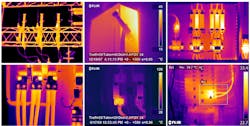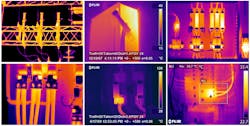In the electrical world, being unaware of the complexity in front of you is dangerous. When it comes to the regulations and standards used to protect employees and, by extension, customers, being unaware of when a person needs to be qualified for specific electrical tasks invites risk.
For example, should a person be considered qualified in thermography to perform infrared thermography on or near electrical equipment? Would he or she also need to be qualified as an electrical person? And how does he or she become qualified in thermography if it is required or recommended?
This article looks at how the regulations and standards fit together to help us understand our responsibility to qualify employees for a specific task, and how standards and training help us meet it.
Standards and regulations
For some tasks, a person may need to be a qualified electrical person. However, they may not need to be a qualified electrical person for other tasks. Determining what tasks a person should be a qualified electrical person for is the responsibility of the employer and must be considered when performing a risk assessment for each task and the job as a whole. Following are the standards and regulations that apply:
1. OSHA (Occupational Safety and Health Administration) 29 CFR 1920
2. NFPA (National Fire Protection Association) 70E (Electrical Safety in the Workplace)
3. NFPA 70 (the National Electric Code [NEC])
4. NFPA 70B (Recommended Practice for Electrical Equipment Maintenance)
5. ANSI/NETA MTS (American National Standards Institute and International Electrical Testing Association)
6. ASNT/ANSI SNT-TC-1A (American Society for Nondestructive Testing and American National Standards Institute)
Step by step
To start, employers that fall under OSHA regulations can look to OSHA and the various NFPA electrical standards for definitions of a qualified electrical person. For example, Art. 100 in the 2021 Edition of NFPA 70E defines a qualified person as, “One who has demonstrated skills and knowledge related to the construction and operation of electrical equipment and installations and has received safety training to identify the hazards and reduce the associated risk.”
When employers are using standards such as NFPA 70E to help them comply with OSHA regulations, it is also mandatory to consider the state of electrical maintenance used to keep the equipment in a safe and efficient operating condition. NFPA 70E Sec. 110.5(C) states: “Condition of Maintenance. The electrical safety program shall include elements that consider condition of maintenance of electrical equipment and systems.”
To learn more about what electrical maintenance is required, an employer would turn to Chapter 2, where maintenance is defined but the specific maintenance methods or testing procedures are not. For example, Sec. 200.1 states, “It is left to the employer to choose from the various maintenance methods available to satisfy the requirements of Chapter 2.”
An informational note at the bottom of Sec. 200.1 lists reference standards that can help an employer (or his or her designated representative) create an effective electrical maintenance program. These include NFPA 70B and ANSI/NETA MTS (Standard for Maintenance Testing Specifications for Electrical Power Distribution Equipment and Systems).
Both standards show a variety of electrical maintenance tasks and values that can be used to understand the health of the electrical equipment during the various tasks.As an example, let’s check if a thermal infrared scan of electrical equipment requires a person to be qualified as an infrared thermographer (a person who uses thermal infrared cameras for nondestructive testing). (See Photo above.) NFPA 70B does recommend that a person is trained and qualified for that task. NFPA 70B 2019, Chapter 11, Sec. 11.17.1.1. states, “Infrared inspections should be performed by qualified and trained personnel who have an understanding of infrared technology, electrical equipment maintenance, and the safety issues involved. Infrared inspections have uncovered a multitude of potentially dangerous situations. Proper diagnosis and remedial action of these situations have also helped to prevent numerous major losses.”
An employer could also find the general requirement that personnel performing tests be trained and qualified in Chapter 6, Sec. 6.2.2.2.4.
ANSI/NETA MTS also discusses qualification of personnel in the test methods. This testing standard is widely used around the world, and it continues to enforce that personnel are trained, experienced, and qualified in the respective test method. Chapter 3 of the 2019 edition of this standard states, “Technicians performing these electrical tests and inspections shall be qualified, trained, and experienced concerning the apparatus and systems being evaluated. These individuals shall be capable of conducting the tests in a safe manner with complete knowledge of the hazards involved. They must be able to evaluate the test data and make judgment on the continued serviceability or nonserviceability of the specific equipment.”
A quick recap
Let’s review how we determined the need to use qualified testing personnel through the standards. First, we started with OSHA and Chapter 1 and 2 in NFPA 70E. Those led us to NFPA 70B, and for thermography specifically, Chapter 11. Both NFPA 70B and ANSI/NETA MTS call for a person to be qualified to perform the thermography testing, but they don’t prescribe how to become qualified in thermal imaging.
To find criteria for qualifying a person in a specific task, we’ll need a standard specific to that task. ANSI/ASNT document SNT-TC-1A provides criteria for becoming qualified in specific nondestructive test methods, including thermal imaging (also known as thermography).
For employers who are unfamiliar with ASNT, it is a nonprofit organization that creates recommended policies and procedures that help maintain a level of professionalism and qualification in nondestructive testing (NDT) methods. (NDT is testing that does not destroy the serviceability of a part or system.) The latest edition of SNT-TC-1A is the 2020 version. This Recommended Practice details what it takes to achieve qualification in the required NDT method. There are three levels of certification.
According to SNT-TC-1A, the employer is responsible for certification in NDT methods. Each employer requires a document defined as a Written Practice to detail their certification program based on the ASNT recommendations: “5.1 The employer shall establish a written practice for the control and administration of NDT personnel training, examination, and certification.”
For a Level I thermographer, ASNI/ANST recommends a minimum of 32 hr of training and 400 hr of NDT experience in the field under the direction of a qualified Level II or III thermographer. In addition, a qualified thermographer at any level is required to be recertified every five years. As part of this recertification process, a minimum of 25% of a person’s annual work must be in the NDT method for which they seek recertification.
When in-house personnel cannot maintain the level of effective experience in infrared due to other job duties, NFPA 70B and ANSI/NETA MTS recommend considering hiring qualified outside consultants that are well trained and experienced in the test methods that will be applied to the electrical equipment.
The recommendation is clear: According to ANSI, a thermal infrared scan of electrical equipment should be performed by a technician qualified as a thermographer.
Wrapping it up
In summary, all the widely used electrical testing standards call for a person to be qualified in any specific test method they use. Proper electrical maintenance is not optional when ensuring the safety of equipment and employees, and it should be part of a company’s electrical safety program. When considering what maintenance needs to be performed, will you have staff that is qualified to do the task, or do you have access to a qualified contractor? Just because a person is a qualified electrician, for example, doesn’t mean they are qualified to perform specific electrical maintenance tasks. Keep this in mind when including an effective electrical preventive maintenance program for your equipment, and only use trained and qualified personnel to perform the necessary tasks.
Joseph DeMonte is the director of technical training and support for Empower Training Services, an electrical safety training program offered by ABM Franchising Group. He can be reached at [email protected].
About the Author
Joseph DeMonte
Joseph DeMonte is the director of technical training and support for Empower Training Services, an electrical safety training program offered by ABM Franchising Group. He can be reached at [email protected].

